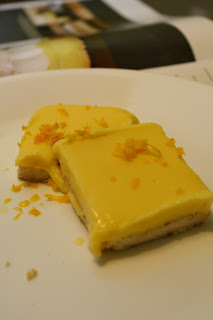
I) Part 4. Truffles. Originally they were supposed to be modeled after the mushrooms of the same name. Essentially they are supposed to look like clods of dirt. For some reason they have gotten a rap for being hard to make. And while they are a bit troublesome, they are not hard to make. Here is a simple recipe using ganache as the base and finishing with a coat of chocolate and nuts.
II) Truffles (taken directly from Alton Brown)
Materials:
- 10 ounces bittersweet chocolate, chopped fine
- 3 tablespoons unsalted butter
- 1/2 cup heavy cream
- 1 tablespoon light corn syrup
- 1/4 cup brandy
- 1/2 cup Dutch process cocoa powder, finely chopped nuts, and/or toasted coconut, for coating truffles
- 8 ounces semisweet or bittersweet chocolate, chopped fine
Method:
Place the 10 ounces of chocolate and butter in a medium size glass mixing bowl. Microwave for 30 seconds. Remove and stir, and repeat this process 1 more time. Set aside.
Heat the heavy cream and corn syrup in a small saucepan over medium heat until simmering. Remove from the heat and pour the mixture over the melted chocolate mixture; let stand for 2 minutes. Using a rubber spatula, stir gently, starting in the middle of bowl and working in concentric circles until all chocolate is melted and mixture is smooth and creamy. Gently stir in the brandy. Pour the mixture into an 8 by 8-inch glass baking dish and place in the refrigerator for 1 hour.
Using a melon baller, scoop chocolate onto a sheet pan lined with parchment paper and return to the refrigerator for 30 minutes.
Place the cocoa powder, nuts, and/or toasted coconut each in its own pie pan and set aside.
In the meantime, place the 8 ounces of chocolate into a medium mixing bowl which is sitting on top of a heating pad lined bowl, with the heating pad set to medium. Depending on the heating pad, you may need to adjust the heat up or down. Stirring the chocolate occasionally, test the temperature of the chocolate and continue heating until it reaches 90 to 92 degrees F; do not allow the chocolate to go above 94 degrees F. If you do, the coating will not have a nice snap to it when you bite into the chocolate. Once you have reached the optimal temperature, adjust the heat to maintain it.
Remove the truffles from the refrigerator and shape into balls by rolling between the palms of your hands. Use powder-free vinyl or latex gloves, if desired.
Dip an ice cream scoop into the chocolate and turn upside down to remove excess chocolate. Place truffles 1 at time into the scoop and roll around until coated. Then place the truffle into the dish with either the cocoa powder, nuts or coconut. Move the truffle around to coat; leave truffle in the coating for 10 to 15 seconds before removing. In the meantime, continue placing the chocolate-coated truffles in the cocoa or other secondary coating. After 10 to 15 seconds, remove the truffle to a parchment lined sheet pan. Repeat until all truffles are coated. Allow to set in a cool dry place for at least 1 hour; or store in an airtight container in the refrigerator. Truffles are best when served at room temperature.
III) Results and Discussion:
These were really easy to make, if messy. I left out the brandy, so the truffles were a bit less smooth. Next time I’ll either add the brandy or some other form of liquid to compensate. Overall really easy and really good. My first foray into chocolate!
IV) Sources:
"Chocolate Truffles Recipe : Alton Brown : Food Network." Food Network - Easy Recipes, Healthy Eating Ideas and Chef Recipe Videos. Web. 27 Jan. 2011. http://www.foodnetwork.com/recipes/alton-brown/chocolate-truffles-recipe/index.html
V) Pictures!















